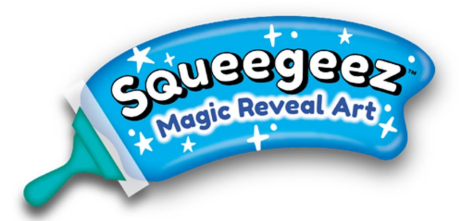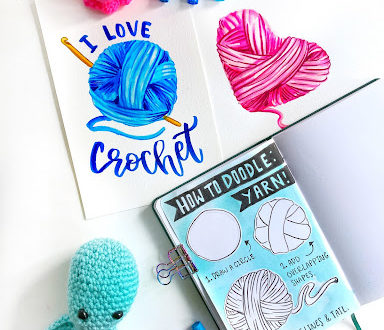
After years of searching and experimenting, UK artist Conor Smith found the medium of Scratchbord and could not put it down. The notoriously unforgiving nature and permanence of the medium draws him to it.

- You began with oil as your primary medium before transitioning to Scratchbord. What inspired this change?
Truth be told, I experimented with a lot of mediums before finally discovering scratchboard. I can remember dabbling with spray paint, oils, pastels, and even coloured pencils. I learned quickly that I enjoyed the dryer mediums more, as I am notoriously clumsy and would get oil paint everywhere in my studio. But for some reason, it always felt like something was missing from the mediums I tried. Whether it was not being able to get crisp, clear lines, having to wait days for the paint to dry, or whether it was not being able to get the bright highlights I wanted. I remember one day scrolling through Instagram and came across a stunning piece of art with amazing contrast and detail. I discovered it was done on scratchboard and knew I had to give it a go. Since then, scratchboard has just felt natural to me. Scratchboard has never been a big medium in the UK and not something I’ve seen many UK artists choose as their primary medium. But that uniqueness is something that also really draws me to the medium. I love explaining what it is and how I create my artwork. That was in 2020, and I haven’t looked back since.
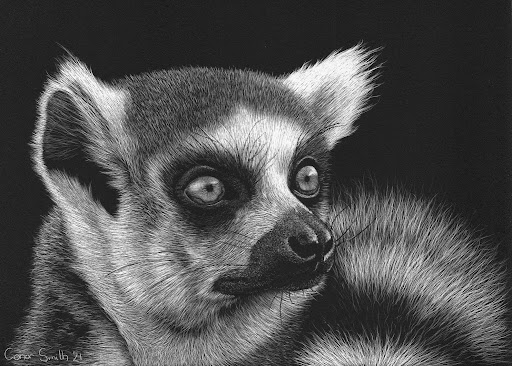
- Are there specific subjects or themes that you find are better suited to Scratchbord. Does this medium allow you to express particular ideas and concepts more effectively?
My passion has always been wildlife art and, more recently, trying to create hyper-realistic wildlife art, so having a medium well suited to this style is great. If you are an artist who loves creating animals and fur, scratchboard is definitely something you should try. Every artist works differently and will find a different way of creating the texture they want to portray. I have always worked best with layering to create fur, as this was how I learned when using pastels, and this transitioned great into the medium of scratchboard, too. I will work as if I am trying to layer fur from closest to the animals’ skin and work my way up to the surface. I find this way of layering gives me the best results, as this is how fur is in nature. One of scratchboard’s features that inspires me to create is the stark contrast you can achieve and the ability to play with light. I have always been drawn to artworks with dramatic lighting, and the ease with which you can achieve this with scratchboard has kept me coming back to this incredible medium.

- As a paramedic alongside your art career, have you discovered therapeutic techniques in your artwork that help alleviate the stress associated with your paramedic duties?
Most definitely. Being a paramedic can undoubtedly be a stressful career choice, and you can regularly go home and spend hours replaying the scenarios from the day in your head. Switching off from the day (or night) is sometimes very difficult. I quickly found that doing artwork was a great stress reliever and allowed me to focus on something aside from my job. Sometimes, I will sit down to do scratchboard, and before I know it, one or two hours have passed, and I’ve not even noticed. You can allow yourself to be focused on your artwork and let your mind get lost in the scratches.
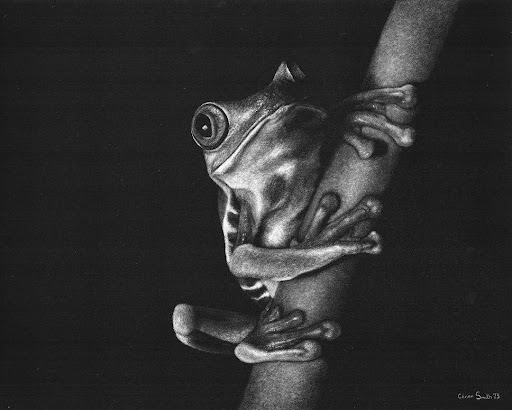
- Can you tell us the inspiration and motivation behind starting your online art academy?
The online Art Academy is one of my most recent projects and is still in the development stages. When I first started with scratchboard, I struggled to find online resources showing how scratchboard works or how to create artwork. I can remember starting with other mediums and finding many videos online explaining how different brushes worked for oils, how to draw an eye with pastels, or even step-by-step tutorials on how to create a colour pencil artwork. I struggled with this early on, and much of my development as a scratchboard artist has been through trial and error. However, experimenting, following different scratchboard artists, studying their techniques, or reaching out and asking questions has helped. Luckily, the scratchboard community is very friendly, and everyone is more than happy to share their experiences and advice on Facebook groups. I am part of the International Society of Scratchboard Artists, with abundant knowledge and skills to draw from. However, I am a visual learner, and sometimes, it really helps to watch a video or follow a step-by-step tutorial and see how certain artists create different textures. And that is where I hope my Art Academy will come in. I intend to develop a library of video resources for people to access, including tutorial videos, step-by-step follow-along videos, information on tools I use, and much more.

- Scratchbord is a unique and highly detailed medium. Can you describe your creative process from conceptualization to execution?
Scratchboard is indeed a highly detailed medium, and that is probably what I love most about it. My process can vary between pieces depending on what I am trying to achieve with a piece. It all starts with inspiration, which can sometimes come very easily or be challenging when stuck with an artist’s block. Inspiration for me can come from many different forms and can come from a specific animal or species, and other times, it can come from some idea that has been floating around in my head for some time. Currently, I’ve been drawn specifically to animal behavior, whether that might be regarding their playfulness or their fight for survival. When I’ve decided what I will do, I go all in. I rarely work on one piece at a time and prefer to concentrate all my effort on one piece. Before starting any piece, I can spend hours examining my reference photo and planning how to tackle each area. Especially if there is an area I expect to be challenging, I will spend time planning what techniques I want to try. This is something I find unique to scratchboard as you have to work out how varying lines and dots will give the impression of fur and skin. My process remains similar for both, working from a very faint layer, slowly building up the brightness and details.
- Can you share some of the tools and techniques you use when working with Scratchbord? Are there any unconventional methods or tools that you have found particularly compelling?
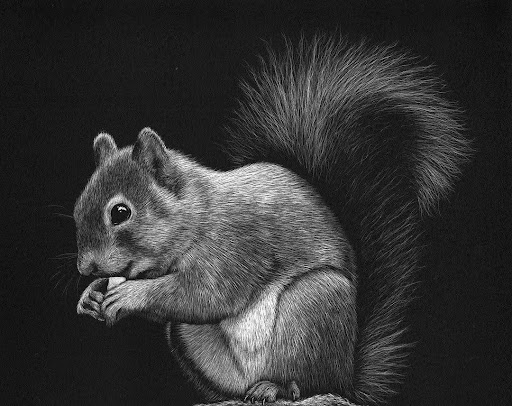
I think where scratchboard comes into its own is with the variety of tools you can use with it. You can use any tool that has the ability to remove ink from the surface, and experimenting with this part is a lot of fun. I have tried a plethora of different tools over the years, varying from tattoo needles and craft knives to ink erasers and sandpaper. I have even experimented using a tattoo machine to create a stippling texture. However, over the years, I have narrowed down my selection to a few go-to tools for each piece. If I create fur, I will use tattoo needles to lay down a faint layer of fur, as I don’t want to go too bright too early. This is usually done with a 5M1 or 1RL tattoo needle. These are relatively cheap and can be brought from Amazon or online tattoo shops. Once this is done, I go back over the top with a craft knife to create those brighter mid-tones and highlights. Creating other textures, such as skin, noses, and eyes, is slightly different. I usually use a stippling technique for this, using either my fibreglass brush or tattoo needles to get a base layer down again. This allows me to map out where the highlights and dark shadows will be. I then go back over refining areas with my craft knife.

- How do you select or capture the reference photos you use?
Reference photos are definitely key in my creative process. I don’t usually have the time or equipment to capture my own references, as much as I would love to. Selecting a reference photo can be a very time-consuming process, sometimes taking only hours but mostly taking days or weeks. Rarely can I find a reference photo that is exactly what I want, so I often choose one that speaks to me in some way. It all depends on what I want to achieve with the scratchboard I create. Sometimes, I will want a reference photo intended for a bigger artwork, where I want a story, dramatic lighting, or something that is impactful. Other times, I may want to practice a certain technique, such as skin, a complicated fur pattern, or a difficult posture. A simple elephant portrait will suffice to achieve my goal, such as wanting to practice elephant skin.

- What advice would you give an artist just starting out with Scratchbord?
For any artist who is either just starting out in scratchboard or wanting to start in scratchboard, I would say go for it and give it time. It’s a medium that is unlike any other medium out there, and with that, you have to give yourself time to learn what you can and can’t do easily with scratchboard. Try not to rush the pieces you are creating. Scratchboard can be a slower medium; building the layers needed to create realism can take time. Some of my pieces can take weeks and even months to finish. I think I’ve only had one artwork completed within one full day of drawing (around 10 hours). If you are trying to render fur texture, you can sometimes be scratching all the individual hairs of an animal, which can take a long time. Finally, I don’t think many people can pick up or start a new medium and create a masterpiece with the first attempt (I certainly can’t), so give it time and patience, and you will be creating amazing artwork in no time.

- What do you love most about Ampersand Scratchbord for your work?
I love the professional feel of Ampersand Scratchbord. Whenever I am scratching, it always feels incredibly smooth, durable, and consistent, and it allows me to get the layers and depth I need for my realism style. Knowing that they are archival and museum quality always gives me the assurance when selling my work that they will last the test of time. I don’t think I would ever use any other brand of scratchboard for my work now.
Artist Bio:
Conor Smith is a scratchboard artist based in Staffordshire in the United Kingdom. He specializes in creating realistic wildlife artwork. He is a member of the International Society of Scratchboard Artists and has been awarded Signature Status. He has created multiple YouTube videos to help inspire and motivate current and new scratchboard artists.
He has been featured on the cover of International Artist Magazine and has been a finalist in the prestigious David Shepherd Wildlife Foundation Wildlife Artist of the Year.
When Conor is not creating, he works as a Paramedic within the National Health Service in the UK. He loves being able to help people as a paramedic, but unfortunately, it doesn’t leave him with a lot of time to pursue his passion for art. However, he says, “In life, I find that you must make time for your passions and hobbies. So, whenever I get the chance, I pick up my tools, and I get scratching.” To see more of Conor’s work, visit his website, Instagram, Facebook, and YouTube.
https://www.instagram.com/conorsstudio




